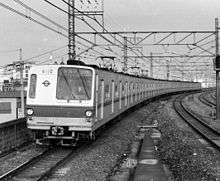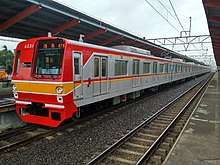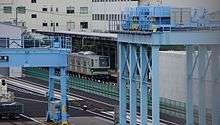Tokyo Metro 6000 series
| Tokyo Metro 6000 series | |
|---|---|
|
A 6000 series train on the Odakyu Odawara Line in June 2006 | |
| In service | 1971–October 2018 (Tokyo Metro) |
| Manufacturer | Kawasaki Heavy Industries, Kinki Sharyo, Kisha Seizō, Nippon Sharyo, Tokyu Car Corporation |
| Constructed | 1968–1990 |
| Refurbishment | 1988–2007 |
| Number built | 36 sets (353 vehicles) |
| Number in service | 26 sets (234 vehicles) for Kereta Commuter Indonesia |
| Successor | Tokyo Metro 16000 series |
| Formation | 3/8/10 cars per trainset |
| Operator(s) |
Eidan/TRTA (1971–2004) Tokyo Metro (2004–2018) Kereta Commuter Indonesia(2011–present) |
| Depot(s) |
Ayase (Tokyo Metro) Depok (KCI) |
| Line(s) served | Tokyo Metro Chiyoda Line, Joban Line, Odakyu Odawara Line |
| Specifications | |
| Car body construction | Aluminium |
| Car length | 20,000 mm (65 ft 7 in) |
| Width | 2,870 mm (9 ft 5 in) |
| Maximum speed | 80 km/h (Chiyoda Line), 90 km/h (Joban Line), 100 km/h (Odawara Line), 70 km/h (On selected railway lines in Kereta Commuter Indonesia) |
| Traction system | Chopper control, IGBT-VVVF, Hitachi VVVF, Mitsubishi VVVF |
| Electric system(s) | 1,500 V DC overhead |
| Braking system(s) | Regenerative braking |
| Track gauge | 1,067 mm (3 ft 6 in) |
The Tokyo Metro 6000 series (東京地下鉄6000系 Tōkyō Chikatetsu 6000-kei) is an electric multiple unit (EMU) train type operated by the Tokyo subway operator Tokyo Metro on the Tokyo Metro Chiyoda Line in Tokyo, Japan since 1971. A number of trainsets have been exported to Indonesia for use by Kereta Commuter Indonesia following their withdrawal in Japan.
The trains have 20 m aluminium 4-door cars, and are used on the Chiyoda Line, as well as Odakyu Odawara Line, and Joban Line (all-stations "local" services). The sole three-car set was used on the Chiyoda Line Kita-Ayase Branchline.
Fleet
- 6000: 1st prototype (1968)
- 6101: 2nd prototype (1969)
- 6102–6121: full production 1st–3rd full-production batch type
- 6122–6135: full production 4th–7th full-production batch type
As of 1 April 2018, the fleet still operating in Japan consists of 2 ten-car sets (sets 02 & 30).[1]
The 6000 series is scheduled its final operation on October 2018, following the very last trainset to be shipped to Jakarta, Indonesia afterwards (Set 30). [2]
Formations
Trains are formed as follows, with car 1 at the southern end.[3]
Set 01
| Car No. | 1 | 2 | 3 | 4 | 5 | 6 | 7 | 8 | 9 | 10 |
|---|---|---|---|---|---|---|---|---|---|---|
| Designation | CM1 | M2 | T1 | Tc1 | M1 | M2 | Tc2 | M2 | M1 | CM2 |
| Numbering | 6101 | 6201 | 6701 | 6601 | 6301 | 6401 | 6501 | 6801 | 6901 | 6001 |
Cars 1 and 3 each have one lozenge-type pantograph, and cars 5 and 9 each have two.[3]
Sets 02-21
| Car No. | 1 | 2 | 3 | 4 | 5 | 6 | 7 | 8 | 9 | 10 |
|---|---|---|---|---|---|---|---|---|---|---|
| Designation | CT1 | M1 | M2 | Tc1 | M1 | M2 | Tc2 | T2 | M1 | CM2 |
| Numbering | 61xx | 63xx | 64xx | 65xx | 67xx | 68xx | 66xx | 62xx | 69xx | 60xx |
Cars 2, 5, and 9 each have two lozenge-type pantographs.[3]
Sets 22-35
| Car No. | 1 | 2 | 3 | 4 | 5 | 6 | 7 | 8 | 9 | 10 |
|---|---|---|---|---|---|---|---|---|---|---|
| Designation | CT1 | T2 | M1 | M2 | Tc1 | Tc2 | M1 | M2 | M1 | CT2 |
| Numbering | 61xx | 62xx | 63xx | 64xx | 65xx | 66xx | 67xx | 68xx | 69xx | 60xx |
Cars 3, 7, and 9 each have two lozenge-type pantographs.[3]
Set 60
| Car No. | 1 | 2 | 3 |
|---|---|---|---|
| Designation | CT | M1 | CM2 |
| Numbering | 6000-1 | 6000-2 | 6000-3 |
Cars 1 and 2 each have one lozenge-type pantograph.[3]
History

Refurbishment
The fleet was retro-fitted with air conditioning between 1988 and 1994.[4] The fleet then underwent a programme of refurbishment between 1988 and 2007.[4]
Resale to Indonesia


A number of 6000 series sets have been shipped to Kereta Commuter Indonesia in Jakarta, Indonesia, as listed below.
VVVF refurbished sets were shipped to Indonesia from 2016, with the first three sets arrived at the Port of Tanjung Priok in Jakarta on 29 July 2016.[5]
The earlier chopper-controlled sets run as eight-car formations, while the refurbished VVVF-controlled sets operate as ten-car formations.[6]
| Set No. | Date shipped |
|---|---|
| 6101 | 2016[7] |
| 6105 | 2012[8] |
| 6106 | September 2011[9] |
| 6107 | 2012[10] |
| 6108 | 2016[7] |
| 6111 | 2012[8] |
| 6112 | September 2011[9] |
| 6113 | 2012[8] |
| 6115 | January 2011[9] |
| 6116 | 2016[11] |
| 6117 | 2016[7] |
| 6118 | 2016[11] |
| 6119 | 2017[12] |
| 6120 | 2017[13] |
| 6121 | 2017[13] |
| 6122 | 2018[14] |
| 6123 | 2012[10] |
| 6124 | 2017[13] |
| 6125 | 2012[10] |
| 6126 | January 2011[9] |
| 6127 | 2012[8] |
| 6129 | 2017[15] |
| 6131 | 2016[16] |
| 6132 | 2017[12] |
| 6133 | 2012[8] |
| 6134 | 2012[8] |
Training set

The three-car prototype set 6000, used on the Kita-Ayase branch line until 2014, is used as a staff training unit at Shin-Kiba Depot in Koto, Tokyo.[17]
Fleet history
The individual set histories are as shown below.[4]
| Batch | Set No. | Manufacturer | Build date | Refurbishment date | Withdrawal date | Remarks |
|---|---|---|---|---|---|---|
| 1st prototype | 6001 | Kisha Seizo | 16 April 1968 | - | Not in regular service. | |
| 2nd prototype | 6101 | Kawasaki Heavy Industries | 27 August 1969[Note 1] | 28 January 1999 | 20 May 2016 | Shipped to Indonesia in 2016.[7] |
| 1st batch | 6102 | Kawasaki Heavy Industries | 5 February 1971 | 17 July 1996 | 05 October 2018 | |
| 6103 | Kawasaki Heavy Industries | 5 February 1971 | - | 26 September 2011 | ||
| 6104 | Kawasaki Heavy Industries | 5 February 1971 | 9 August 1995 | March 2016 | ||
| 6105 | Kawasaki Heavy Industries | 12 March 1971 | - | 10 September 2012 | Shipped to Indonesia. | |
| 6106 | Nippon Sharyo | 5 February 1971 | 6 January 1998 | 9 September 2011 | Shipped to Indonesia. | |
| 6107 | Nippon Sharyo | 5 February 1971 | 18 January 1991 | 30 January 2012 | Shipped to Indonesia. | |
| 6108 | Tokyu Car Corporation | 12 March 1971 | 11 May 1998 | 21 June 2016 | Shipped to Indonesia in 2016.[7] | |
| 6109 | Kawasaki Heavy Industries | 5 February 1971 | April 1988 | 23 October 2015 | ||
| 6110 | Kinki Sharyo | 12 March 1971 | - | 1 October 2010 | ||
| 6111 | Nippon Sharyo | 5 February 1971 | - | 13 August 2012 | Shipped to Indonesia. | |
| 6112 | Kisha Seizo | 12 March 1971 | 31 August 1990 | 8 September 2011 | Shipped to Indonesia. | |
| 6113 | Kisha Seizo | 12 March 1971 | - | 20 August 2012 | Shipped to Indonesia. | |
| 2nd batch | 6114 | Kawasaki Heavy Industries | 22 August 1972 | 25 November 1996 | January 2016 | |
| 6115 | Kawasaki Heavy Industries | 6 September 1972 | - | 20 January 2011 | Shipped to Indonesia. | |
| 6116 | Kawasaki Heavy Industries | 22 August 1972 | 9 November 1995 | 15 August 2016 | Shipped to Indonesia in 2016.[11] | |
| 6117 | Nippon Sharyo | 6 September 1972 | 18 September 1998 | 27 June 2016 | Shipped to Indonesia in 2016.[7] | |
| 6118 | Tokyu Car Corporation | 6 September 1972 | 13 June 1997 | 29 August 2016 | Shipped to Indonesia in 2016.[11] | |
| 6119 | Kisha Seizo | 22 August 1972 | 24 February 1997 | 30 January 2017 | Shipped to Indonesia in 2017.[12] | |
| 3rd batch | 6120 | Kawasaki Heavy Industries | 7 October 1977 | 29 August 1997 | 29 May 2017 | Shipped to Indonesia in 2017.[13] |
| 6121 | Nippon Sharyo | 21 September 1977 | July 2000 | 21 April 2017 | Shipped to Indonesia in 2017.[13] | |
| 4th batch | 6122 | Kinki Sharyo | 10 April 1981 | 30 March 2007 | 27 January 2018 | Shipped to Indonesia in 2018.[14] |
| 6123 | Nippon Sharyo | 10 April 1981 | - | 2 February 2012 | Shipped to Indonesia. | |
| 6124 | Kawasaki Heavy Industries | 15 May 1981 | 6 January 2004 | 10 April 2017 | Shipped to Indonesia in 2017.[13] | |
| 6125 | Kawasaki Heavy Industries | 26 June 1981 | - | 17 February 2012 | Shipped to Indonesia. | |
| 6126 | Nippon Sharyo | 31 July 1981 | - | 11 January 2011 | Shipped to Indonesia. | |
| 6127 | Nippon Sharyo | 26 August 1981 | - | 17 September 2012 | Shipped to Indonesia. | |
| 6128 | Kawasaki Heavy Industries | 14 September 1981 | 17 June 2004 | 6 December 2015 | ||
| 5th batch | 6129 | Nippon Sharyo | 24 November 1984 | 18 October 2006 | 10 July 2017 | Shipped to Indonesia in 2017.[15] |
| 6130 | Kinki Sharyo | 12 December 1984 | 21 November 2005 | to be shipped on 2018 | ||
| 6131 | Tokyu Car Corporation | 11 January 1985 | 16 May 2005 | 10 October 2016 | Shipped to Indonesia in 2016.[16] | |
| 6132 | Kawasaki Heavy Industries | 21 February 1985 | 17 May 2006 | 27 March 2017 | Shipped to Indonesia in 2017.[12] | |
| 6th batch | 6133 | Kinki Sharyo | 8 October 1988 | - | 3 September 2012 | Shipped to Indonesia. |
| 6134 | Kinki Sharyo | 24 October 1988 | - | 27 August 2012 | Shipped to Indonesia. | |
| 7th batch | 6135 | Tokyu Car Corporation | 26 September 1990 | - | 12 December 2011 |
- ↑ Cars 6501 to 6801 were built in February 1971.
References
- ↑ 私鉄車両編成表 2016 [Private Railway Rolling Stock Formations - 2016] (in Japanese). Japan: Kotsu Shimbunsha. 25 July 2016. pp. 74–75. ISBN 978-4-330-70116-5.
- ↑ Tokyo Metro (in Japanese). Japan. 28 September 2018 http://www.tokyometro.jp
|archiveurl=missing title (help). Archived from the original (PDF) on 28 September 2018. Retrieved 29 September 2018. - 1 2 3 4 5 私鉄車両編成表 私鉄車両編成表 2015 [Private Railway Rolling Stock Formations - 2015] (in Japanese). Japan: Kotsu Shimbunsha. 23 July 2015. pp. 72–73. ISBN 978-4-330-58415-7.
- 1 2 3 Kekke, Manabu (June 2016). 本数を減らす東京メトロ6000系の現況 [The current state of the dwindling Tokyo Metro 6000 series]. Tetsudo Daiya Joho Magazine (in Japanese). Vol. 45 no. 386. Japan: Kotsu Shimbun. pp. 30–35.
- ↑ "KERETA API: KCJ Tambah KRL Untuk Perbanyak Kapasitas Angkut" [RAILWAY: KCJ Adds Train Fleet to Expand Capacity] (in Indonesian). Indonesia: Bisnis.com. 29 July 2016. Retrieved 31 July 2016.
- ↑ Takagi, Satoru (January 2018). ジャカルタ 東京地下鉄関連の車両 [Tokyo Metro rolling stock in Jakarta]. Japan Railfan Magazine (in Japanese). Vol. 58 no. 681. Japan: Koyusha Co., Ltd. pp. 120–121.
- 1 2 3 4 5 6 私鉄車両のうごき [Private railway rolling stock changes]. Tetsudo Daiya Joho Magazine (in Japanese). Vol. 45 no. 390. Japan: Kotsu Shimbun. October 2016. p. 127.
- 1 2 3 4 5 6 私鉄車両のうごき [Private Rail Rolling Stock Changes]. Tetsudō Daiya Jōhō Magazine. Vol. 42 no. 345. Japan: Kotsu Shimbun. January 2013. p. 127.
- 1 2 3 4 千代田線6000系、さらに6106・6112編成がインドネシアへ [Chiyoda Line 6000 series to Indonesia]. Japan Railfan Magazine. Vol. 52 no. 609. Japan: Koyusha Co., Ltd. January 2012. p. 174.
- 1 2 3 私鉄車両のうごき [Private Rail Rolling Stock Changes]. Tetsudō Daiya Jōhō Magazine. Vol. 41 no. 339. Japan: Kotsu Shimbun. July 2012. p. 127.
- 1 2 3 4 私鉄車両のうごき [Private railway rolling stock changes]. Tetsudo Daiya Joho Magazine (in Japanese). Vol. 46 no. 393. Japan: Kotsu Shimbun. January 2017. p. 127.
- 1 2 3 4 私鉄車両のうごき [Private railway rolling stock changes]. Tetsudo Daiya Joho Magazine (in Japanese). Vol. 46 no. 399. Japan: Kotsu Shimbun. July 2017. p. 127.
- 1 2 3 4 5 6 私鉄車両のうごき [Private railway rolling stock changes]. Tetsudo Daiya Joho Magazine (in Japanese). Vol. 46 no. 402. Japan: Kotsu Shimbun. October 2017. p. 127.
- 1 2 "Nyaris Datang Tahun Lalu, KRL Seri 6000 Rangkaian 6122F Buka Impor KRL 2018". www.re-digest.web.id.
- 1 2 私鉄車両のうごき [Private railway rolling stock changes]. Tetsudo Daiya Joho Magazine (in Japanese). Vol. 47 no. 405. Japan: Kotsu Shimbun. January 2018. p. 105.
- 1 2 私鉄車両のうごき [Private railway rolling stock changes]. Tetsudo Daiya Joho Magazine (in Japanese). Vol. 46 no. 396. Japan: Kotsu Shimbun. April 2017. p. 128.
- ↑ Shibata, Togo (March 2017). 非公開の保存車両に注目 [Looking at rolling stock preserved in private]. Tetsudo Daiya Joho Magazine (in Japanese). Vol. 46 no. 395. Japan: Kotsu Shimbun. p. 59.
External links
| Wikimedia Commons has media related to Tokyo Metro 6000 series. |
- Tokyo Metro Chiyoda Line 6000 series information (in Japanese)
